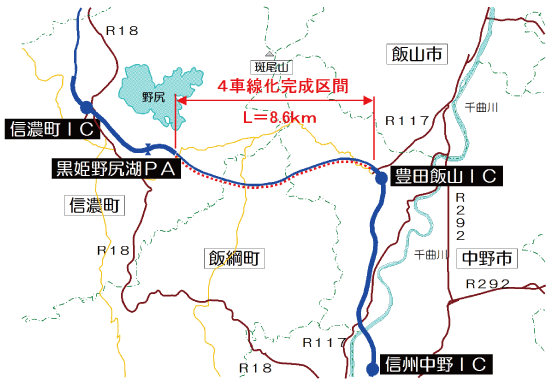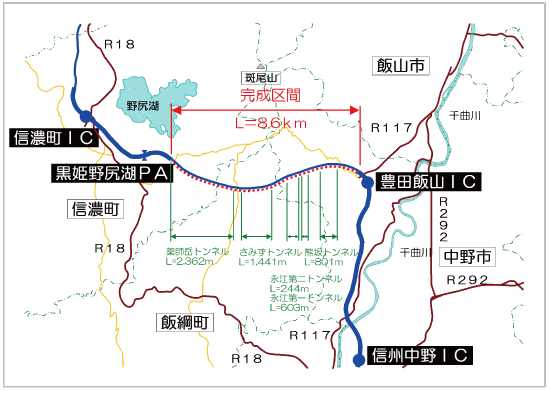上信越自動車道(豊田飯山IC~信濃町IC間)の4車線化工事が完成します
~ 上信越道がより安全に、より快適に走行できます ~
平成21年10月13日
東日本高速道路株式会社
NEXCO東日本(東京都千代田区、代表取締役会長:八木重二郎)が建設を進めてまいりました上信越自動車道 豊田飯山インターチェンジ(IC)~信濃町IC間(8.6km)の4車線化工事が、平成21年11月19日(木)に完成します。
今回の4車線化により、80km/h(規制速度)で走行することが可能になり、観光シーズン等で交通集中により発生していた渋滞を解消することができ、より安全・快適に走行することができます。
4車線化完成区間の概要
- 上信越道(豊田飯山IC~信濃町IC間) 延長:8.6km
- 工事区間
長野県 中野市(なかのし) 大字(おおあざ) 永江(ながえ)から
長野県 上水内郡(かみみのちぐん) 信濃町(しなのまち) 大字(おおあざ) 富濃(とみの)まで - 位置図

上信越自動車道豊田飯山IC~信濃町IC間4車線化
1.4車線化工事概要
上信越自動車道は、関越自動車道藤岡JCT(群馬県藤岡市)から西へ分岐し、更埴JCT(長野県千曲市)で長野自動車道、上越JCT(新潟県上越市)で北陸自動車道と接続する延長約203kmの高速道路です。
平成11年10月の中郷IC~上越JCT間の開通により全線開通しており、関越自動車道、中央自動車道、長野自動車道及び北陸自動車道と広域ネットワークを形成することにより、上信越地方の沿線地域の経済・産業・文化等の発展に貢献する重要な役割を果たす路線です。
4車線化事業については、暫定2車線での開通後、長野県と新潟県を結ぶ動脈としての役割を担い物流・観光等に大きく寄与し、交通量は着実な伸びを示していたことから、平成10年12月に信州中野IC~信濃町IC間の施行命令を受けました。そして、信州中野IC~豊田飯山IC間から4車線化工事に着手し、同区間は平成17年4月29日に4車線化を完了しました。
残る豊田飯山IC~信濃町IC間の4車線化(8.6km)が今回完成することとなりました。

2.完成の効果
今回の完成により、対向車線への飛び出し事故が解消され、安全性の向上の他に以下のような円滑で快適な走行が可能になります。
(1) 混雑期の渋滞解消
豊田飯山IC~信濃町IC間の年平均交通量は約11,000台/日(※1)であり、交通混雑期(ゴールデンウィーク、お盆、年末年始)には交通集中による渋滞が発生しております。今回の完成により当該区間の交通集中による渋滞は解消します。
- 1 平成20年(1月~12月)平均日交通量
(2) 夜間工事による通行止めの解消
当該区間では、毎年9月上旬に道路を維持・管理する上で必要な補修作業を行うため、夜間通行止めを実施していましたが、4車線化により車線規制による補修作業が可能となるため、夜間通行止めがなくなります。
(3) 規制速度の向上と定時性の確保
4車線化されることにより、規制速度が70km/hから80km/hに変更されます。また、追越も可能となり定時性の確保に寄与することが期待されます。

- 交通量は、ETC車以外も含む全車種合計の断面交通量(トラフィックカウンター[道路に備え付けられている交通量(概数)の自動計測装置])による速報値
- 渋滞回数は、渋滞長1km以上の交通集中渋滞をカウント
